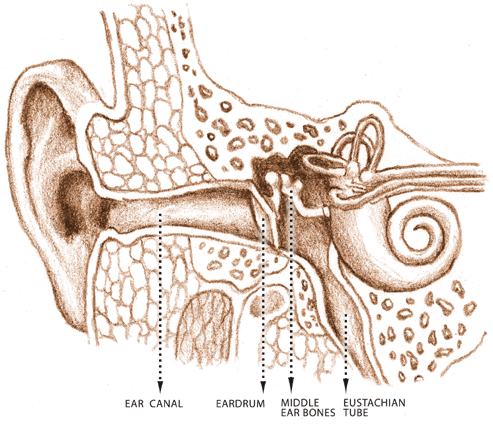"Do You Hear
What I Hear?"
Reconstructive Ear Surgery
Michelle Facer, DO
Otolaryngology/ENT
Northern Pines Ear, Nose & Throat
Eau Claire
Hearing loss can greatly affect quality of life and how you function
on a day-to-day basis.
The ringing of a telephone, a bird singing or a loved one's laugh may
be missed if you suffer from hearing loss. The good news is that some
types of hearing loss can be improved and allow you to again enjoy the
rich sounds surrounding you.
There are two types of hearing loss, sensorineural and conductive. Sensorineural
hearing loss typically results in a loss of nerve function and can only
be improved with hearing aids, or in profound cases, with cochlear implants.
Conductive hearing losses, on the other hand, can be repaired surgically.
Diagnostic testing by an audiologist and an examination by an Otorhinolaryngologist
( Ear, Nose and Throat physician) can help to delineate the type and
extent of hearing loss.
Conductive hearing loss results when sound is not conducted
through the ear in a normal manner. This can occur when the eardrum
does not vibrate normally or when the middle ear bones (ossicles) do
not pass sound vibrations on to the middle ear. The most common example
of the eardrum not vibrating normally occurs when there is fluid behind
the eardrum in the middle ear. This is very common in children who sometimes
have tubes placed to correct the problem.
If there is a hole in the eardrum or tympanic membrane, sound cannot
be conducted normally. This can result from trauma or chronic ear infections.
Besides a hearing loss, other symptoms associated with a perforated
eardrum include: pain, pressure or discomfort in the ear; drainage from
the ear; and ringing in the ear. Surgery, commonly known as a myringoplasty
or tympanoplasty, results in the creation of a new eardrum (graft) and
thus improves hearing. The procedure allows the patient to swim and
get the ear wet while bathing. The graft is made from a piece of your
own tissue that is used to patch the hole in the eardrum.

If the conductive hearing loss is a result of a problem with the middle
ear bones or ossicles, this can be surgically repaired as well. The
ossicles consist of the three smallest bones in the body: the hammer
(malleus), anvil (incus), and stirrup (stapes). Common causes of ossicular
problems include chronic ear infections, abnormal tissue growth (cholesteatoma),
or abnormal bone growth. Sometimes, there is a strong family history
of hearing loss (otosclerosis), and family members may not be aware
that the hearing can be surgically restored.
During surgery, a microscope is used to identify the source of the
problem. A prosthesis is then selected which will replace one or more
of the damaged or missing middle ear bones. Occasionally, a laser is
used to facilitate the process. These procedures are usually performed
on an outpatient basis. Hearing results are almost always excellent
and allow the patient to function without the need for a hearing aid.
Within six weeks, patients typically hear better than they have in years.
In fact, chances are, you will now be able to enjoy the sounds of music,
laughter and conversation.
For more information or to schedule an appointment
with Dr. Michelle Facer » 715- 831-3300, Northern Pines Ear, Nose
& Throat, Eau Claire. Dr. Facer also sees patients in Cumberland
and Shell Lake.



